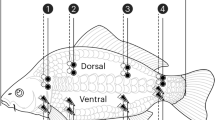Abstract
Objectives: To assess the reliability of bioelectric impedance analysis (BIA) for predicting total body water (TBW) and extracellular water (ECW) in obese children.
Design: Comparison of five prediction models based on: (i) body weight (Wt), (ii) the impedance (Z) index (ZI=height2/Z), (iii) the association of Wt and ZI, (iv) the body surface area (SA) to impedance ratio (SA:Z) and, (v) the body volume (V) to impedance ratio (V:Z).
Subjects: Thirty obese and 25 control children of 11.2±1.8 y of age.
Measurements: TBW and ECW were assessed by deuterium and bromide dilution; Z was measured at frequencies of 5, 50 and 100 kHz.
Results: In controls, Wt explained 11% more variance of TBW than ZI (r2=0.977, SEE=0.9 I, CV=3.8%) and the association of Wt and ZI improved the prediction of TBW only slightly (r2=0.982, SEE=0.8 I, CV=3.5%). The SA:Z and V:Z indexes explained 6 and 33% less variance of TBW respectively as compared to Wt alone. In obese subjects, ZI explained 4% more variance of TBW than Wt (r2=0.914, SEE=1.8 I, CV=6.4%) and the SA:Z ratio was the most accurate predictor of TBW (r2=0.959, SEE=1.2 I, CV=4.4%). However, the increase in the explained variance of TBW associated to the use of the SA:Z ratio was of only 1% as compared to the association of ZI and Wt. The V:Z ratio explained 9% less of variance of TBW as compared to ZI. In both control and obese subjects, the association of Wt and ZI offered the best prediction of ECW (r2=0.807, SEE=1.564 I and r2=0.826, SEE=1.035 I, respectively). However, the values of CV were much higher in controls than in obese children (17.5% vs 8.4%) owing to their lower ECW and greater variability in ECW%. ZI was the most accurate predictor of TBW on the pooled sample (n=55; r2=0.910, SEE=1.932 I, CV=7.4%). However, it was a poor predictor of ECW on the same sample owing to its high CV (n=55; r2=0.866, SEE=1.806 I, CV=17.0%).
Conclusions: The body surface area to impedance ratio is the most accurate predictor of TBW in obese children but the association of ZI and Wt may be of more interest when BIA is used to estimate both TBW and ECW. The impedance index offers a good prediction of TBW but not of ECW in children with different levels of fatness.
Sponsorship: Supported by grant 9304260.CT04 from CNR, Italy.
Similar content being viewed by others
Author information
Authors and Affiliations
Rights and permissions
About this article
Cite this article
Bedogni, G., Bollea, M., Severi, S. et al. The prediction of total body water and extracellular water from bioelectric impedance in obese children. Eur J Clin Nutr 51, 129–133 (1997). https://doi.org/10.1038/sj.ejcn.1600351
Received:
Revised:
Accepted:
Issue Date:
DOI: https://doi.org/10.1038/sj.ejcn.1600351
- Springer Nature Limited
Keywords
This article is cited by
-
Body water distribution in severe obesity and its assessment from eight-polar bioelectrical impedance analysis
European Journal of Clinical Nutrition (2005)
-
Comparison of bioelectrical impedance analysis and dual-energy X-ray absorptiometry for the assessment of appendicular body composition in anorexic women
European Journal of Clinical Nutrition (2003)
-
Accuracy of an eight-point tactile-electrode impedance method in the assessment of total body water
European Journal of Clinical Nutrition (2002)
-
Foot-to-foot bioelectrical impedance analysis: a valuable tool for the measurement of body composition in children
International Journal of Obesity (2001)
-
Validating a practical approach to determine weight control in obese children and adolescents
International Journal of Obesity (2000)




